

【C++】从零开始的CS:GO逆向分析2——配置GLFW+IMGUI环境并创建透明窗口 - 水风井
source link: https://www.cnblogs.com/water-wells/p/16728845.html
Go to the source link to view the article. You can view the picture content, updated content and better typesetting reading experience. If the link is broken, please click the button below to view the snapshot at that time.

1.配置glfw
解压后使用Visual Studio打开文件夹
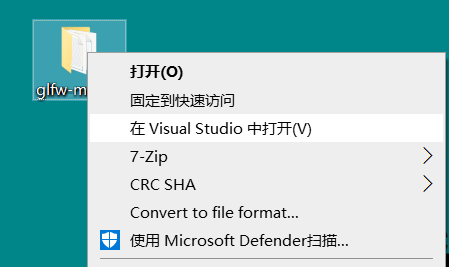

选择全部重新生成,然后选择 安装->glfw
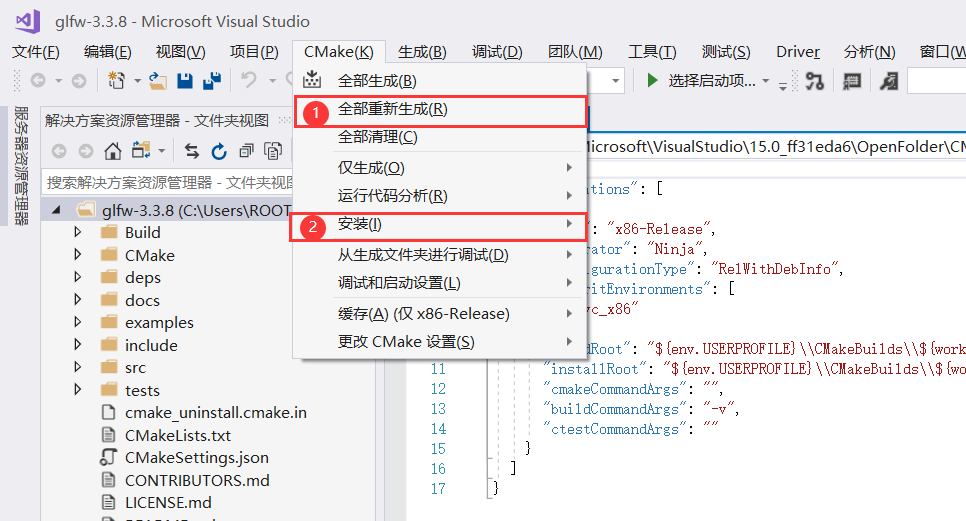
在下面的生成信息可以看到需要的文件生成的位置

打开后,将include、lib文件夹复制到自己的工程文件夹
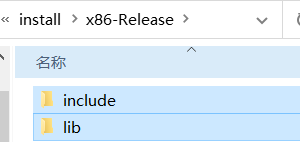
加入后配置自己的工程

项目属性->c/c++ ->常规 下的附加包含目录,输入$(ProjectDir)include 添加
项目属性->链接器->常规 下的附加库目录 ,输入$(ProjectDir)lib 添加
项目属性->链接器->输入 下的附加依赖项 输入 glfw3.lib;opengl32.lib; 添加
配置好后,用代码测试一下
#include <GLFW/glfw3.h>
#pragma comment(lib,"glfw3.lib")
int main(void)
{
GLFWwindow* window;
/* Initialize the library */
if (!glfwInit())
return -1;
/* Create a windowed mode window and its OpenGL context */
window = glfwCreateWindow(640, 480, "Hello World", NULL, NULL);
if (!window)
{
glfwTerminate();
return -1;
}
/* Make the window's context current */
glfwMakeContextCurrent(window);
/* Loop until the user closes the window */
while (!glfwWindowShouldClose(window))
{
/* Render here */
glClear(GL_COLOR_BUFFER_BIT);
/* Swap front and back buffers */
glfwSwapBuffers(window);
/* Poll for and process events */
glfwPollEvents();
}
glfwTerminate();
return 0;
}
如果出现一个窗口则说明配置正确,配置有问题的可以检查一下包含的目录 是不是 自己复制到的目录
2.配置IMGUI+glfw
打开glfw下载Binaries
把文件夹里的glew32s.lib复制到自己项目的lib文件夹里
把GL文件夹复制到之前的include文件夹里
在项目属性->链接器->输入 下的附加依赖项 中增加 glew32s.lib;
在项目属性 ->c/c++ ->预处理器 的预处理定义下增加GLEW_STATIC
在实例代码中增加头文件 #include<GL/glew.h>
在
if (!glfwInit())
return -1;
后增加代码
glewInit(); (增加的代码),成功运行则配置成功
下载IMGUI
在自己项目的include文件夹下新建一个imgui文件夹,将imgui-master中以下的文件复制进去
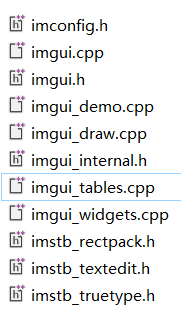
打开imgui的example项目,找到example_glfw_opengl3,在自己项目include文件夹中,创建这五个同名文件,将内容保存进去(其实就是把这几个文件也复制过去)
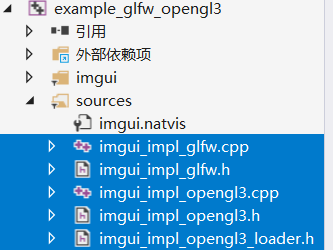
在自己的项目中新建筛选器(imgui),添加现有项,将include/imgui文件夹里的cpp文件都添加进去

测试代码,如果正常创建则环境正常
// Dear ImGui: standalone example application for GLFW + OpenGL 3, using programmable pipeline
// (GLFW is a cross-platform general purpose library for handling windows, inputs, OpenGL/Vulkan/Metal graphics context creation, etc.)
// If you are new to Dear ImGui, read documentation from the docs/ folder + read the top of imgui.cpp.
// Read online: https://github.com/ocornut/imgui/tree/master/docs
#include "imgui/imgui.h"
#include "imgui/imgui_impl_glfw.h"
#include "imgui/imgui_impl_opengl3.h"
#include <stdio.h>
#if defined(IMGUI_IMPL_OPENGL_ES2)
#include <GLES2/gl2.h>
#endif
#include <GLFW/glfw3.h> // Will drag system OpenGL headers
// [Win32] Our example includes a copy of glfw3.lib pre-compiled with VS2010 to maximize ease of testing and compatibility with old VS compilers.
// To link with VS2010-era libraries, VS2015+ requires linking with legacy_stdio_definitions.lib, which we do using this pragma.
// Your own project should not be affected, as you are likely to link with a newer binary of GLFW that is adequate for your version of Visual Studio.
#if defined(_MSC_VER) && (_MSC_VER >= 1900) && !defined(IMGUI_DISABLE_WIN32_FUNCTIONS)
#pragma comment(lib, "legacy_stdio_definitions")
#endif
static void glfw_error_callback(int error, const char* description)
{
fprintf(stderr, "Glfw Error %d: %s\n", error, description);
}
int main(int, char**)
{
// Setup window
glfwSetErrorCallback(glfw_error_callback);
if (!glfwInit())
return 1;
// Decide GL+GLSL versions
#if defined(IMGUI_IMPL_OPENGL_ES2)
// GL ES 2.0 + GLSL 100
const char* glsl_version = "#version 100";
glfwWindowHint(GLFW_CONTEXT_VERSION_MAJOR, 2);
glfwWindowHint(GLFW_CONTEXT_VERSION_MINOR, 0);
glfwWindowHint(GLFW_CLIENT_API, GLFW_OPENGL_ES_API);
#elif defined(__APPLE__)
// GL 3.2 + GLSL 150
const char* glsl_version = "#version 150";
glfwWindowHint(GLFW_CONTEXT_VERSION_MAJOR, 3);
glfwWindowHint(GLFW_CONTEXT_VERSION_MINOR, 2);
glfwWindowHint(GLFW_OPENGL_PROFILE, GLFW_OPENGL_CORE_PROFILE); // 3.2+ only
glfwWindowHint(GLFW_OPENGL_FORWARD_COMPAT, GL_TRUE); // Required on Mac
#else
// GL 3.0 + GLSL 130
const char* glsl_version = "#version 130";
glfwWindowHint(GLFW_CONTEXT_VERSION_MAJOR, 3);
glfwWindowHint(GLFW_CONTEXT_VERSION_MINOR, 0);
//glfwWindowHint(GLFW_OPENGL_PROFILE, GLFW_OPENGL_CORE_PROFILE); // 3.2+ only
//glfwWindowHint(GLFW_OPENGL_FORWARD_COMPAT, GL_TRUE); // 3.0+ only
#endif
// Create window with graphics context
GLFWwindow* window = glfwCreateWindow(1280, 720, "Dear ImGui GLFW+OpenGL3 example", NULL, NULL);
if (window == NULL)
return 1;
glfwMakeContextCurrent(window);
glfwSwapInterval(1); // Enable vsync
// Setup Dear ImGui context
IMGUI_CHECKVERSION();
ImGui::CreateContext();
ImGuiIO& io = ImGui::GetIO(); (void)io;
//io.ConfigFlags |= ImGuiConfigFlags_NavEnableKeyboard; // Enable Keyboard Controls
//io.ConfigFlags |= ImGuiConfigFlags_NavEnableGamepad; // Enable Gamepad Controls
// Setup Dear ImGui style
ImGui::StyleColorsDark();
//ImGui::StyleColorsLight();
// Setup Platform/Renderer backends
ImGui_ImplGlfw_InitForOpenGL(window, true);
ImGui_ImplOpenGL3_Init(glsl_version);
// Load Fonts
// - If no fonts are loaded, dear imgui will use the default font. You can also load multiple fonts and use ImGui::PushFont()/PopFont() to select them.
// - AddFontFromFileTTF() will return the ImFont* so you can store it if you need to select the font among multiple.
// - If the file cannot be loaded, the function will return NULL. Please handle those errors in your application (e.g. use an assertion, or display an error and quit).
// - The fonts will be rasterized at a given size (w/ oversampling) and stored into a texture when calling ImFontAtlas::Build()/GetTexDataAsXXXX(), which ImGui_ImplXXXX_NewFrame below will call.
// - Read 'docs/FONTS.md' for more instructions and details.
// - Remember that in C/C++ if you want to include a backslash \ in a string literal you need to write a double backslash \\ !
//io.Fonts->AddFontDefault();
//io.Fonts->AddFontFromFileTTF("../../misc/fonts/Roboto-Medium.ttf", 16.0f);
//io.Fonts->AddFontFromFileTTF("../../misc/fonts/Cousine-Regular.ttf", 15.0f);
//io.Fonts->AddFontFromFileTTF("../../misc/fonts/DroidSans.ttf", 16.0f);
//io.Fonts->AddFontFromFileTTF("../../misc/fonts/ProggyTiny.ttf", 10.0f);
//ImFont* font = io.Fonts->AddFontFromFileTTF("c:\\Windows\\Fonts\\ArialUni.ttf", 18.0f, NULL, io.Fonts->GetGlyphRangesJapanese());
//IM_ASSERT(font != NULL);
// Our state
bool show_demo_window = true;
bool show_another_window = false;
ImVec4 clear_color = ImVec4(0.45f, 0.55f, 0.60f, 1.00f);
// Main loop
while (!glfwWindowShouldClose(window))
{
// Poll and handle events (inputs, window resize, etc.)
// You can read the io.WantCaptureMouse, io.WantCaptureKeyboard flags to tell if dear imgui wants to use your inputs.
// - When io.WantCaptureMouse is true, do not dispatch mouse input data to your main application, or clear/overwrite your copy of the mouse data.
// - When io.WantCaptureKeyboard is true, do not dispatch keyboard input data to your main application, or clear/overwrite your copy of the keyboard data.
// Generally you may always pass all inputs to dear imgui, and hide them from your application based on those two flags.
glfwPollEvents();
// Start the Dear ImGui frame
ImGui_ImplOpenGL3_NewFrame();
ImGui_ImplGlfw_NewFrame();
ImGui::NewFrame();
// 1. Show the big demo window (Most of the sample code is in ImGui::ShowDemoWindow()! You can browse its code to learn more about Dear ImGui!).
if (show_demo_window)
ImGui::ShowDemoWindow(&show_demo_window);
// 2. Show a simple window that we create ourselves. We use a Begin/End pair to created a named window.
{
static float f = 0.0f;
static int counter = 0;
ImGui::Begin("Hello, world!"); // Create a window called "Hello, world!" and append into it.
ImGui::Text("This is some useful text."); // Display some text (you can use a format strings too)
ImGui::Checkbox("Demo Window", &show_demo_window); // Edit bools storing our window open/close state
ImGui::Checkbox("Another Window", &show_another_window);
ImGui::SliderFloat("float", &f, 0.0f, 1.0f); // Edit 1 float using a slider from 0.0f to 1.0f
ImGui::ColorEdit3("clear color", (float*)&clear_color); // Edit 3 floats representing a color
if (ImGui::Button("Button")) // Buttons return true when clicked (most widgets return true when edited/activated)
counter++;
ImGui::SameLine();
ImGui::Text("counter = %d", counter);
ImGui::Text("Application average %.3f ms/frame (%.1f FPS)", 1000.0f / ImGui::GetIO().Framerate, ImGui::GetIO().Framerate);
ImGui::End();
}
// 3. Show another simple window.
if (show_another_window)
{
ImGui::Begin("Another Window", &show_another_window); // Pass a pointer to our bool variable (the window will have a closing button that will clear the bool when clicked)
ImGui::Text("Hello from another window!");
if (ImGui::Button("Close Me"))
show_another_window = false;
ImGui::End();
}
// Rendering
ImGui::Render();
int display_w, display_h;
glfwGetFramebufferSize(window, &display_w, &display_h);
glViewport(0, 0, display_w, display_h);
glClearColor(clear_color.x * clear_color.w, clear_color.y * clear_color.w, clear_color.z * clear_color.w, clear_color.w);
glClear(GL_COLOR_BUFFER_BIT);
ImGui_ImplOpenGL3_RenderDrawData(ImGui::GetDrawData());
glfwSwapBuffers(window);
}
// Cleanup
ImGui_ImplOpenGL3_Shutdown();
ImGui_ImplGlfw_Shutdown();
ImGui::DestroyContext();
glfwDestroyWindow(window);
glfwTerminate();
return 0;
}
至此,环境配置完毕
让鼠标事件透过创建的窗口
glfwWindowHint(GLFW_MOUSE_PASSTHROUGH, GLFW_TRUE);
让窗口透明
glfwWindowHint(GLFW_TRANSPARENT_FRAMEBUFFER, true);
置顶窗口
glfwWindowHint(GLFW_FLOATING, true);
禁止更改窗口大小
glfwWindowHint(GLFW_RESIZABLE, false);
窗口最大化
glfwWindowHint(GLFW_MAXIMIZED, true);
设置没有标题栏
glfwSetWindowAttrib(window, GLFW_DECORATED, false);
删除掉没有用的代码,删掉界面显示的代码,设置窗口透明,设置窗口最大化,设置鼠标通过,设置窗口不允许resize,就可以得到一个透明的窗口,即下面的代码
#include <stdio.h>
#include<Windows.h>
#include <GLFW/glfw3.h>
#include "imgui/imgui.h"
#include "imgui/imgui_impl_glfw.h"
#include "imgui/imgui_impl_opengl3.h"
#include "imgui/alifont.hpp"
static void glfw_error_callback(int error, const char* description)
{
fprintf(stderr, "Glfw Error %d: %s\n", error, description);
}
int main()
{
glfwSetErrorCallback(glfw_error_callback);
if (!glfwInit())
return 1;
GLFWmonitor *monitor = glfwGetPrimaryMonitor();
//###########################设置窗口###########################
const char* glsl_version = "#version 130";
int Height = glfwGetVideoMode(monitor)->height;
int Width = glfwGetVideoMode(monitor)->width;
glfwWindowHint(GLFW_FLOATING, true);
glfwWindowHint(GLFW_RESIZABLE, false);
glfwWindowHint(GLFW_MAXIMIZED, true);
glfwWindowHint(GLFW_TRANSPARENT_FRAMEBUFFER, true);
glfwWindowHint(GLFW_MOUSE_PASSTHROUGH, GLFW_TRUE);
//###########################设置窗口###########################
GLFWwindow* window = glfwCreateWindow(Width, Height, "titile", NULL, NULL);
if (window == NULL)
return 1;
glfwSetWindowAttrib(window, GLFW_DECORATED, false); //设置没有标题栏
ShowWindow(GetConsoleWindow(), SW_HIDE);
glfwMakeContextCurrent(window);
glfwSwapInterval(1);
IMGUI_CHECKVERSION();
ImGui::CreateContext();
ImGuiIO& io = ImGui::GetIO(); (void)io;
ImGui::StyleColorsDark();
ImGui_ImplGlfw_InitForOpenGL(window, true);
ImGui_ImplOpenGL3_Init(glsl_version);
while (!glfwWindowShouldClose(window))
{
glfwPollEvents();
glClear(GL_COLOR_BUFFER_BIT);
ImGui_ImplOpenGL3_NewFrame();
ImGui_ImplGlfw_NewFrame();
ImGui::NewFrame();
ImGui::Render();
int display_w, display_h;
glfwGetFramebufferSize(window, &display_w, &display_h);
glViewport(0, 0, display_w, display_h);
ImGui_ImplOpenGL3_RenderDrawData(ImGui::GetDrawData());
glfwSwapBuffers(window);
}
// Cleanup
ImGui_ImplOpenGL3_Shutdown();
ImGui_ImplGlfw_Shutdown();
ImGui::DestroyContext();
glfwDestroyWindow(window);
glfwTerminate();
return 0;
}
至此,已经配置好了glfw+imgui的环境,并且创建了透明窗口,下一章用第一篇里的偏移值做点事
Recommend
About Joyk
Aggregate valuable and interesting links.
Joyk means Joy of geeK